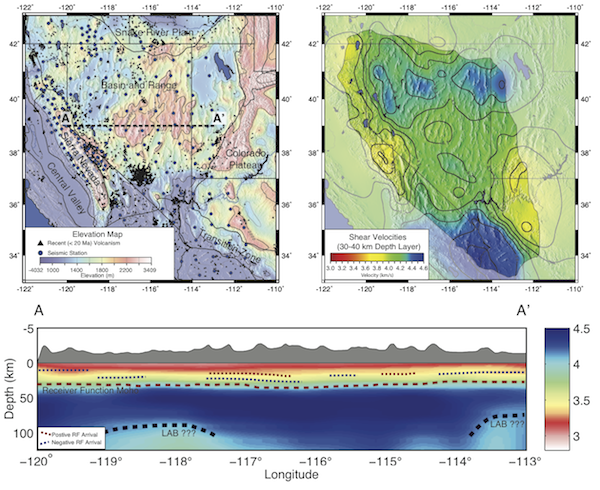2012 IRIS Workshop
Seismic Structure of the Lithosphere Within the Great Basin
Ryan C. Porter: Department of Terrestrial Magnetism, Carnegie Institution of Washington; Matthew J. Fouch: Department of Terrestrial Magnetism, Carnegie Institution of Washington
Preliminary images of shear velocities from ambient noise tomography (ANT) and seismic discontinuities from receiver functions (RFs) for the Great Basin. 1) Map of study area showing major physiographic features, post-20 Ma volcanism, and the location of the cross section in panel 3. 2) Map of Sv velocities for 30-40 km layer from ANT. 3) Cross section A-A’ of Sv velocities. Thick red dashed line shows Moho location from RFs. Lithosphere-Asthenosphere boundary (LAB) inferred from ANT model.

Full-resolution graphics file in original format: 0030.ai
There are many unanswered questions about crustal and mantle interactions in extensional tectonic settings. In order to better understand extensional processes, we use seismic data to analyze the largest continental rift on Earth, the Basin and Range province in the western United States. The attached figures show initial receiver function (RF) and Ambient Noise Tomography (ANT) measurements from the region using data from EarthScope’s USArray Transportable Array and other openly available stations. The first panel shows elevations and the locations of < 20 Ma volcanism in the Great Basin from the NAVDAT database. This image highlights the lack of recent volcanism within the area of high topography in the Basin and Range. The second and third panels show that thicker crust and lithosphere are also present within the center of this region. The area of thicker crust and lithosphere correlates spatially with a previously inferred zone of vertical mantle flow [West et al., 2009, Nature Geoscience]. If downwelling is occurring in this area, it can explain the high topography, thick lithosphere, thick crust, and lack of recent volcanism within the center of the Basin and Range. It can also provide an explanation for the thinner lithosphere and recent volcanism around the periphery of the Great Basin. Further investigation is required to test the mantle downwelling and other hypotheses to evaluate the origin of these regional lithospheric structural variations. Our, initial results, however, suggest that interactions between the lithosphere and asthenosphere may be playing a profound role in regional variations in modern Basin and Range deformation.
Acknoweldgements: Financial support for this work came from National Science Foundation grant EAR- 1053317 (MJF EarthScope Great Basin grant) and the Carnegie Institution of Washington’s Department of Terrestrial Magnetism.
Keywords: great_basin, ambient_noise, receiver_functions
